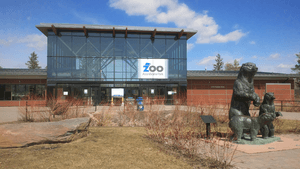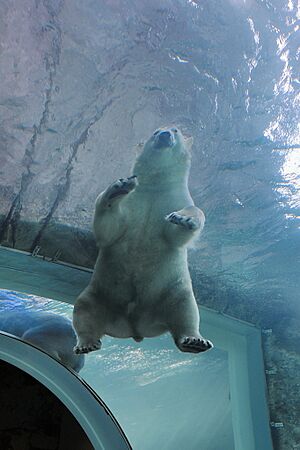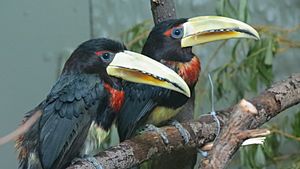Assiniboine Park Zoo facts for kids

Assiniboine Park Zoo entrance
|
|
| Date opened | 1904 |
|---|---|
| Location | 2595 Roblin Boulevard Winnipeg, Manitoba R3P 2N7 |
| Land area | 32 hectares (80 acres) |
| Coordinates | 49°52′09″N 97°13′50″W / 49.86917°N 97.23056°W |
| No. of species | 200 |
| Memberships | CAZA |
| Major exhibits | 11 |
The Assiniboine Park Zoo is a large zoo located in Winnipeg, Manitoba, Canada. It covers about 80-acre (32 ha) of land. The zoo first opened its doors in 1904. It is part of the larger Assiniboine Park. The Assiniboine Park Conservancy manages the zoo. It is officially recognized by the Canadian Association of Zoos and Aquariums (CAZA) and the Association of Zoos and Aquariums (AZA).
For many years, the Assiniboine Park Zoo has been famous for its polar bear exhibit. The original polar bear home was updated in 2013. It was replaced with a new, exciting area called Journey to Churchill.
Contents
History of the Zoo
The zoo started small in 1904. The City of Winnipeg Parks Board bought some local animals. These included deer, bison, and elk. By 1909, the zoo had 116 animals from 19 different kinds of species. A special home for bears was built in 1908.
The zoo grew a lot over the years. By 1998, it had many more animals. There were 390 mammals of 77 different species. It also had 700 birds from 151 species. Plus, there were 34 reptiles from 14 species. In total, the zoo was home to about 1,193 animals.
The first lion, a female, arrived in 1935. In 1939, the zoo got its first polar bear. It was a wild cub named Carmichael who had lost its parents. A female polar bear named Clementine joined Carmichael in 1940.
In 1956, a group called the Zoological Society of Manitoba was formed. They helped the zoo with ideas and money. In 1957, the zoo created "Aunt Sally's Farm." This was a special petting zoo for children. It opened in 1959. At first, there was a small fee to enter. Later, this fee was removed. In 1959, the zoo was officially named Assiniboine Park Zoo.
The 1960s brought more changes. A building for gibbons and monkeys was built. More orphaned polar bear cubs came to live at the zoo. A snow leopard also joined the animal family. The polar bear area was updated in 1967. New sections like the Tropical House and Native Animal Exhibit were added in 1968 and 1969.
In the 1980s, the Zoological Society of Manitoba became active again. They helped fund new signs, exhibits, and buildings. The main entrance was rebuilt. It included a new Gift Store. The Carousel Restaurant was also updated.
New homes for camels, yaks, and zebras opened in 1995. An exciting "Camel Oasis" playground was also built. This was also the first year for "Lights of the Wild." This event showed animal light sculptures in the winter.
In 1997, the "Saturn Playground" was built. The main restaurants were also updated. In 1998, the Saturn Shuttle and a new information booth were added. The zoo's electrical system was also improved.
In 2001, a grant helped turn an old restaurant into the Palliser Interpretive Center. This became a base for ICE Camp. The zoo also started "Mini U Zoo" with the University of Manitoba. Campers spent time at both the university and the zoo. The zoo also shared its big plan for the future with the public.
The zoo's hours changed over time. As late as 2000, it was open until sunset. Later, the closing time became 4 p.m. In July 2015, the zoo tried staying open until 8 p.m. on Wednesdays. This was because many visitors wanted longer hours. In 2004, the Education Centre was greatly improved. This was a project with the University of Manitoba.
Zoo's Big Plan
In 2000, the zoo started working on a new big plan. This was the first major plan since 1960. It began with ideas to redesign the polar bear area. But it soon grew into a much larger project for the whole zoo.
In 2008, the Assiniboine Park Conservancy was created. This group now helps plan and manage Assiniboine Park and the zoo. In June 2009, they shared a huge plan. It was a $200 million project to redevelop the park and zoo over 10 years.
Exhibits and Facilities
The Assiniboine Park Zoo has many amazing exhibits. Each one is designed to give animals a great home. They also help visitors learn about wildlife.
Journey to Churchill
The International Polar Bear Conservation Centre opened in January 2012. The exciting Journey to Churchill exhibit opened in July 2014. This area shows animals from northern Manitoba. It has large habitats for polar bears, Arctic foxes, wolves, musk oxen, caribou, and snowy owls. There are also seals.
Visitors can enjoy interactive displays. They can watch a short film in a 360-degree theatre. There are also underwater tunnels. Here, you can see polar bears and seals swimming! The town of Churchill is in northern Manitoba. It is known as the "Polar Bear Capital of the World."
Inside Journey to Churchill, you can find the Tundra Grill. This restaurant has 150 seats. It offers great views of the largest polar bear habitat.
Toucan Ridge
Toucan Ridge was once called the Tropical House. This building is 1,230 m2 (13,200 sq ft) big. It was built in 1971 and opened in November 1972. The Tropical House almost doubled the number of animal species at the zoo. It featured many birds and other animals. The temperature inside was kept warm, around 27 °C (80 °F).
In 2009, there were plans to tear down the Tropical House. Instead, the zoo decided to reuse most of the building. They changed how the animal displays were set up. This project cost $900,000 for building updates. The exhibit changes cost $2.1 million. The work took five months to finish.
On April 20, 2011, Toucan Ridge opened. This was the first new exhibit in the zoo's big redevelopment plan. Toucan Ridge shows animals, birds, and plants from the tropics. These are found in Central and South America. Toucan Ridge is located in the building that used to be the Tropical House.
Kinsmen Discovery Centre
The Kinsmen Discovery Centre opened on March 23, 1990. It is 743 m2 (8,000 sq ft) in size. This center replaced the older Aunt Sally's Farm. Aunt Sally's Farm was a petting zoo that operated from 1959 to 1989.
The Kinsmen Discovery Centre has six different areas. These areas show different kinds of life. They include water, grasslands, air, and underground. There are also two forest areas. A statue honoring Winnipeg the Bear was put up in 1992. This bear became famous as Winnie-the-Pooh. The statue has since moved to the Nature Playground in the park. This center is the zoo's second largest indoor exhibit. It features fish, snakes, reptiles, and more.
Animals of Asia
In June 2010, the Pavilion of Lions opened. A pair of African Lions were the first animals to live there. In April 2012, the Assiniboine Park Zoo became the only place in North America with Asiatic lions. These Asiatic lions replaced the African lions in the exhibit.
A new, larger home for Siberian tigers was built in 2013. This new area is 2,400 m2 (26,000 sq ft) big. It helps with the tiger breeding program.
Grasslands and Boreal Forest
After Journey to Churchill opened in 2014, the zoo decided to add a wolf exhibit. This was not part of the original plan. It opened in June 2018. This exhibit is home to four male grey wolves and one female grey wolf.
McFeetors Heavy Horse Centre
The McFeetors Heavy Horse Centre is 1.9 ha (4.7 acres) in size. It was announced in September 2014. It officially opened on August 28, 2015. This center focuses on large draft horses.
Stingray Beach
Stingray Beach is an exhibit that changes. It first opened in May 2019.
Seasonal Exhibits
Shirley Richardson Butterfly Garden
The Shirley Richardson Butterfly Garden opened in June 2009. It is 200 m2 (2,200 sq ft) in size. It is located next to the Toucan Ridge exhibit. This garden is a permanent seasonal exhibit. It closes during the winter months.
The Zoo Lights Festival is a special event. It takes place between late fall and early winter. It started in 2019.
Former Exhibits
The zoo has had several special exhibits that are no longer there.
A special Australian exhibit was created in 1993. It featured koalas from the San Diego Zoo. This exhibit was open from May to September. The space later housed Matchie's tree kangaroos.
Boo at the Zoo was a Halloween event. It started in 1996. In its first year, 40,000 people visited. By 2006, over 57,000 people attended. This event is no longer offered.
Lights of the Wild showed animal light sculptures. It first opened in 1996 for three weeks in the winter. This event stopped in 2000.
A temporary exhibit called Xtreme Bugs was at the zoo in the summer of 2018.
Admission Fees
For many years, entering the zoo was free. The zoo tried different ways to raise money. These included coin boxes and a gift shop. By 1993, the zoo decided to start charging an admission fee. This money helps with zoo upkeep and new exhibits.
In 2015, the zoo offered discount Tuesdays for adults. The adult admission fee was later raised to $12. The zoo has offered free children's admission during the Christmas Break in some years.
As of 2019, the admission fees for the Assiniboine Park Zoo are:
| Entrance
Fee |
|
|---|---|
| Age 3-12 | $11.25 |
| Age 13-17 | $17.75 |
| Student (with ID) | $17.75 |
| Adults (up to age 59) | $20.50 |
| Seniors | $17.75 |
Education at the Zoo
The zoo offers many educational programs.
- It hosts summer day camps for children of all ages.
- It provides guided tours for schools and other groups.
Accreditation
In September 2014, the Assiniboine Park Zoo received a special recognition. It became one of only five Canadian zoos to be accredited by the Association of Zoos & Aquariums. This means the zoo meets high standards for animal care and safety.
Conservation Efforts
The Assiniboine Park Zoo is involved in conservation. It participates in Species Survival Programs. These programs help protect endangered animals.




